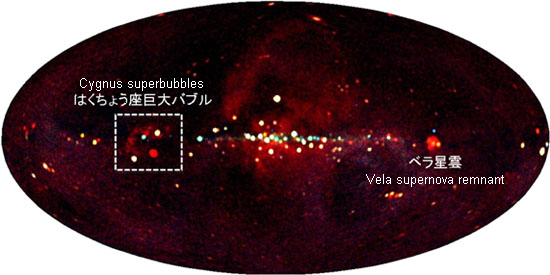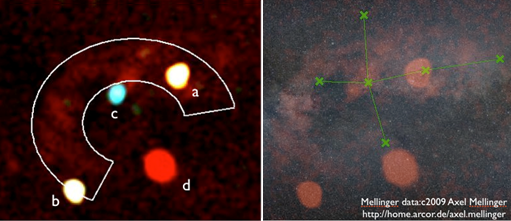This is an archive of information released in the past.
Disclaimer: It may contain broken links or outdated information. Some parts may not function in current web browsers.
*Visit https://humans-in-space.jaxa.jp/en/ for the latest information.

Experiment
- News
- Kibo Utilization Strategy
- Kibo Utilization Plan
- List of JAXA's Utilization Themes
- Experiment Facilities
- Space Environment Utilization
- Archive
MAXI detects a hypernova remnant - the world's first discovery in the Milky Way Galaxy
The Monitor of All-sky X-ray Image (MAXI), one of the Exposed Facility payloads of the Japanese Experiment Module, Kibo of the International Space Station (ISS) has detected the remnant of a hypernova explosion in the direction of Cygnus. Since the explosion was 100 times as large as those of standard supernovae, the remnant was assumed as a hypernova. On the Milky Way Galaxy we live, hypernovae and the remnants have never been discovered. This discovery is the first time in the world.
Outside the Galaxy, there are eight hypernovae and two remnants have been discovered until now. While numerous hypernovae have been discovered because of their extremely bright emission, remnants are difficult to discover because they are as dark as the normal remnants of supernovae, which makes difficult to distinguish one from the other. For these reasons, the Hubble Space Telescope is used to conduct precise observation.
Since August, 2009, the X-ray CCD Solid-state Slit Camera (SSC) onboard MAXI has been observing the high-temperature area for the all-sky. Some wide high-temperature emission was observed in the Cygnus direction. As a result of our analysis, we concluded that there was high possibility that the emission was a remnant of hypernovae exploded 2-3 million years ago.
The result was accepted by the English Publications of the Astrophysical Society of Japan (PASJ). The manuscript title is "Is the Cygnus Superbubble a Hypernova Remnant?"
Explanation
In Galaxies, there are many clumps of high-temperature gas generated by supernovae. They are seen like bubbles if taken with an X-ray camera. In other Galaxies outside the Milky Way Galaxy we live, superbubbles, which are bigger than the bubbles generated by supernovae, have been observed.Thorough X-ray observation so far, superbubbles are assumed to exist in our Galaxy; however, the superbubbles are too huge for observing the previous narrow-field telescopes. This MAXI-SSC is able to observe the all-sky, thus enables the observation for the distribution of ultra-high temperature area. Using the SSC, emission lines of heavy metals with the temperature of 3 million degrees Celsius were detected from the major structure of Cygnus, which can be seen as wide as 11 degrees in semi-diameter from the Earth.
The team calculated the whole amount of the energy and the dimension. As a result, the team concluded that the high-temperature area of the Cygnus was generated 2-3 million years ago, by the energy of 100 times bigger than those of normal supernovae. From these findings, the team interprets that a gigantic star which was several ten times heavier than the sun exploded (a hypernova explosion).
Normal supernova is said to occur once about every 50 years in our Galaxy, while a hypernova is a rare phenomenon assumed to occur only once in hundred thousand to 1 million years. The gigantic explosive energy affects the evolution of Galaxies. Hypernova are considered to generate gamma-ray burst, the largest explosion in space, are related to the source of the ultrahigh energy cosmic rays, and are also assumed to emit strong gravitational waves.
This observation discovered the signature of such rare phenomenon in our Galaxy for the first time in the world. The signature is not visible; however, the explosion 2-3 million years ago could be seen as bright as the full moon.

X-ray observed by MAXI/SSC
Fig. 1 All-sky image with energy bands from 0.7-7.0 keV obtained by MAXI/SSC for 30 months. Center of the image shows the galactic center, galactic longitude is shown on the abscissa, and galactic latitude is shown on the ordinate. The red indicates low energy X-ray emission, while the blue indicates high X-ray energy emission. Bubbles are the point sources of X-ray, and several large-scale structures such as the Vela supernova remnant and the Veil Nebula are seen.

X-ray observed by MAXI/SSC
Left: Enlarged image of the Cygnus superbubbles. The high temperature area is indicated in a white, horseshoe shaped. There are four bright celestial objects (a-d), of which three are the X-ray source points of Cyg X-1 (a), Cyg X-2 (b), and Cyg X-3 (c), and the (d) is the Veil Nebula.
Right: Layered optical light photo and X-ray data. Northern Cross of the Cygnus is shown in green.
Horseshoe shaped, high-temperature structure seen through X-ray ranges 11 degrees in radius, which means the structure is a bubble shaped structure of about 1,000 light-years in radius and is not visible. The distance from the Earth is about 5,500 light-years with the temperature of the gas estimated to be about 3 million degrees Celsius. From these findings, we interpret that hypernova explosions were produced by some gigantic star which was several ten times larger than the sun over the past 2-3 million years.
Title: Is the Cygnus Superbubble a Hypernova Remnant?
Responsible author: Masashi Kimura (JAXA)
Osaka University: Hiroshi Tsunemi, Masayuki Sasaki
JAXA: Hiroshi Tomida, Shiro Ueno
Institute of Physical and Chemical Research (RIKEN): Mutsumi Sugizaki
University of Miyazaki: Takanori Hanayama, Koshiro Yoshidome
MAXI team
See also:
RIKEN MAXI web page
*All times are Japan Standard Time (JST)
| Copyright 2007 Japan Aerospace Exploration Agency | Site Policy |